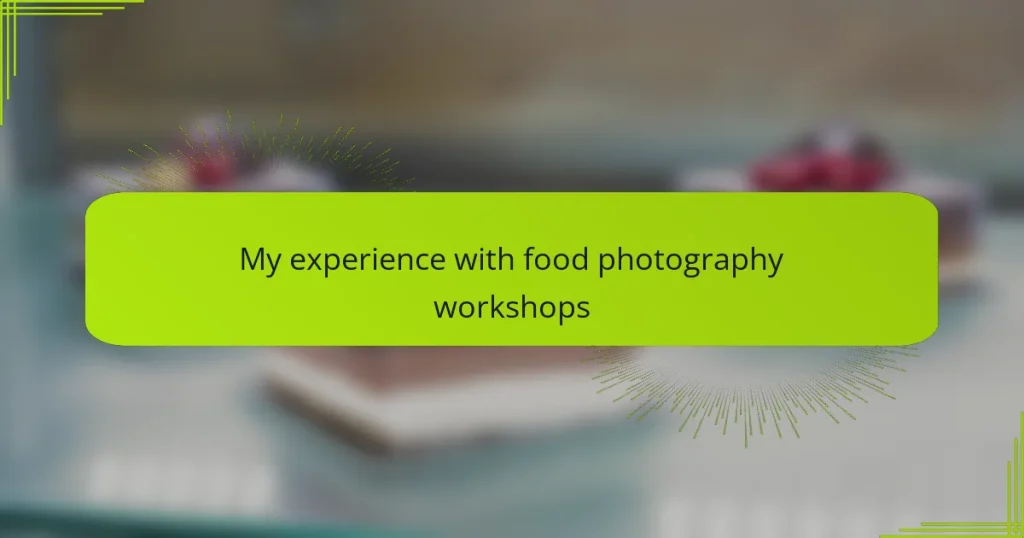Key takeaways
- Natural lighting and camera angles are crucial for creating dynamic and appetizing food photographs.
- Using quality equipment like DSLR cameras and tripods significantly enhances image stability and detail.
- Post-shoot editing is essential for refining images, focusing on subtle enhancements that improve overall appeal.
- Patience and mindfulness in styling and shooting help capture the perfect moment, elevating the quality of dessert photography.
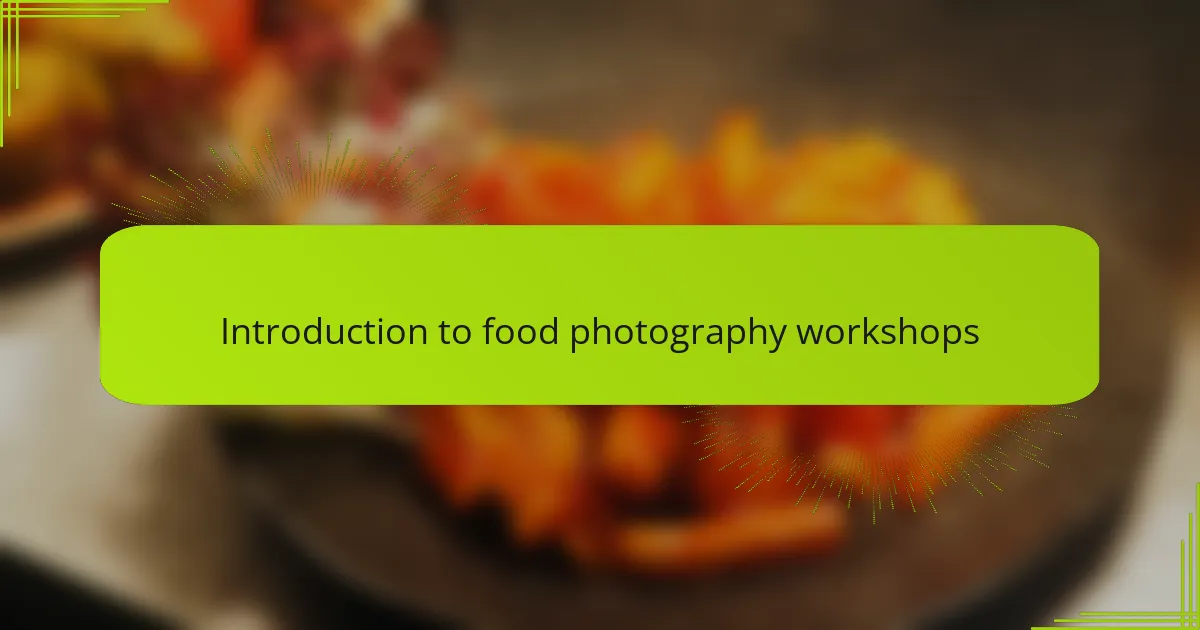
Introduction to food photography workshops
Food photography workshops are a game-changer for anyone passionate about capturing delicious treats in the best light. When I first joined one, I was amazed at how much I didn’t know about angles, lighting, and styling—things that now make my dessert photos pop. Have you ever wondered why some food pics make your mouth water while others feel flat? These workshops show you the secrets behind that magic.
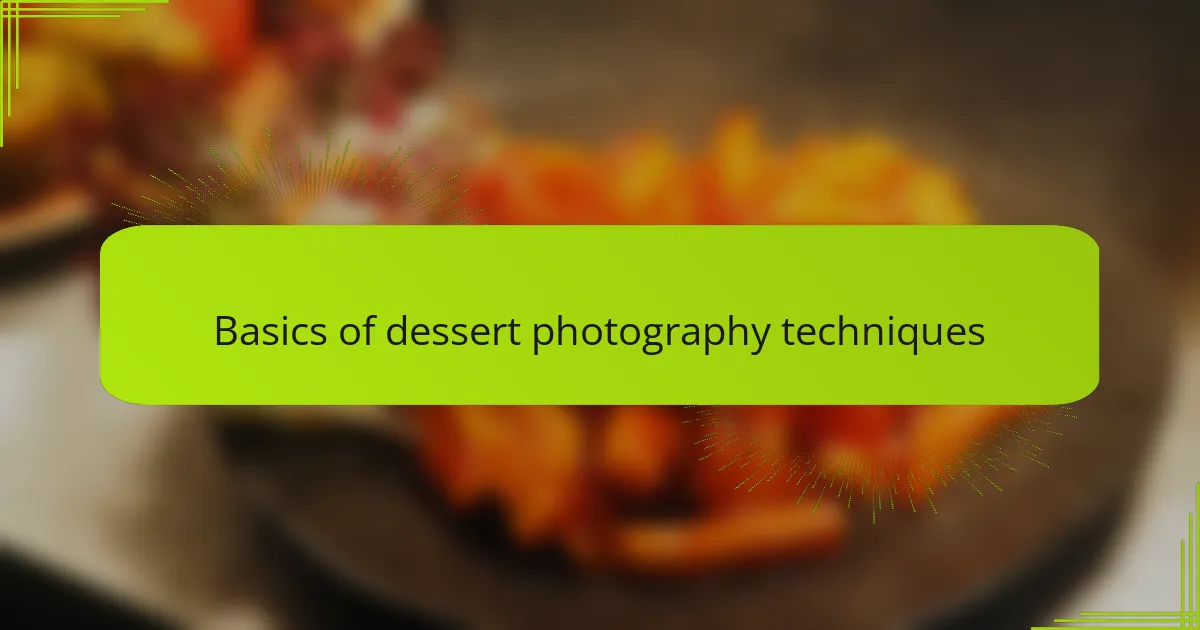
Basics of dessert photography techniques
One fundamental lesson I learned early on was about natural lighting. It surprised me how harsh flash could ruin the soft, inviting look of a cupcake or a silky mousse. Have you noticed how a simple window light makes desserts look almost edible through the screen? That gentle glow brings out colors and textures in a way that instantly grabs attention.
Angles also play a surprisingly huge role. I used to shoot everything straight on, thinking that was best, but experimenting with overhead shots or a shallow side angle completely changed how the desserts told their story. It’s like giving each treat a personality—not just a picture. When I adjusted my perspective, my photos felt more dynamic and mouthwatering.
Styling was another eye-opener. I used to think just placing the dessert on a plate was enough, but adding small props, fresh ingredients, or even a simple sprinkle of powdered sugar helped me create scenes that invite you to linger. It made me realize dessert photography isn’t just about the food itself—it’s about crafting a moment you want to taste. Have you tried making your photos into a story rather than just a snapshot? It changes everything.
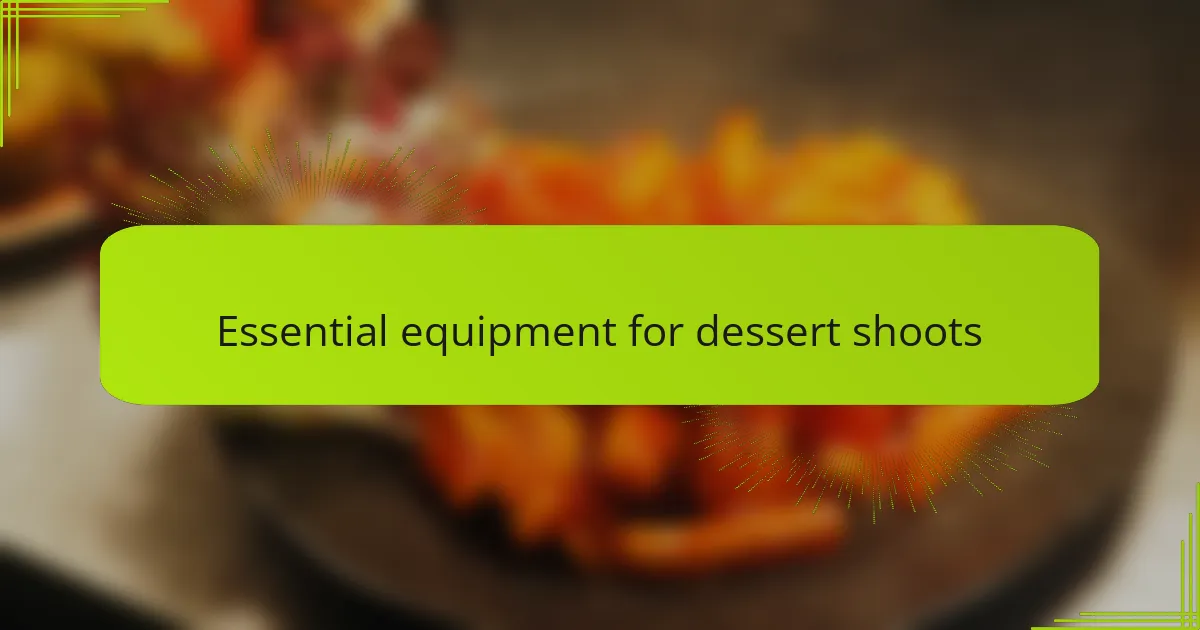
Essential equipment for dessert shoots
When I first showed up with just my phone camera, I quickly realized that having the right equipment makes all the difference. A good DSLR or mirrorless camera was a game-changer for me—it gave me control over focus and exposure that felt impossible before. Have you ever struggled with blurry shots or weird colors? Investing in a quality lens, especially a macro or a lens with a wide aperture, helped me capture every glossy drip and crumb in stunning detail.
Tripods might sound boring, but trust me, they are anything but. Using one brought stability to my shots, allowing me to play with longer exposures in natural light without the fear of shaky images. It also freed my hands to style the dessert just right, which made a huge difference in my workflow and final results.
And then there are the little things—reflectors and diffusers. These simple tools taught me how to manipulate light to soften shadows or bounce highlights back onto my desserts. At first, I thought natural light alone was enough, but adding these accessories made my photos glow with a professional polish. Have you ever seen a dessert photo so bright and inviting that you almost reach through the screen? That’s the magic these tools help you create.
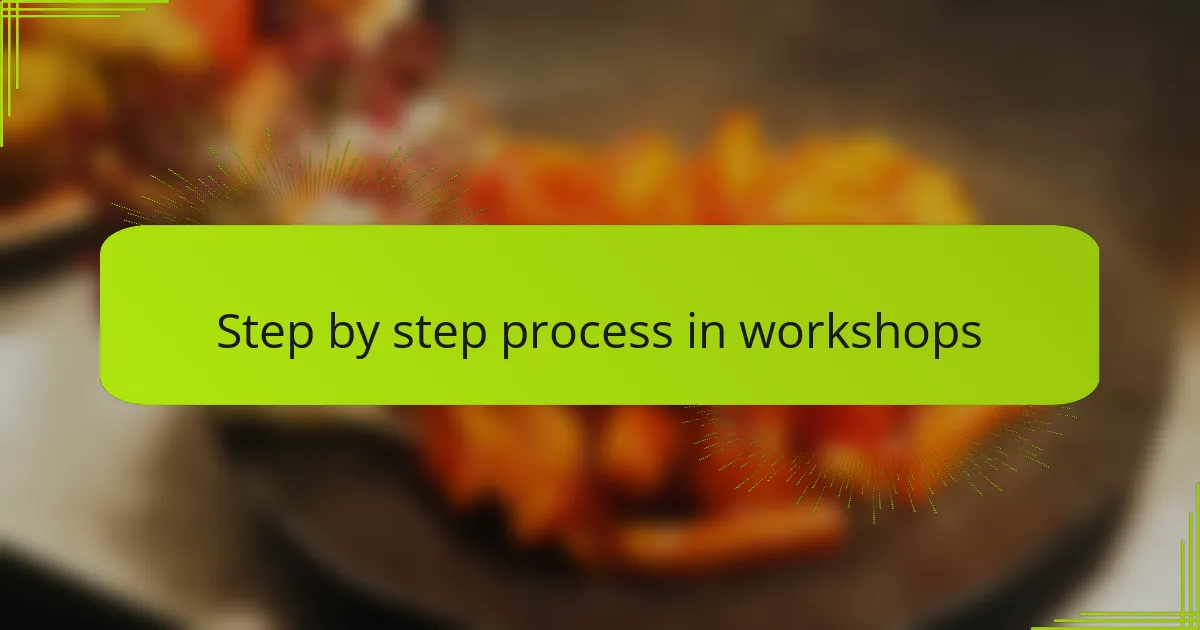
Step by step process in workshops
The workshop began with a hands-on demonstration where the instructor guided us through setting up the perfect shot. I remember fumbling with the camera settings at first, but the step-by-step approach broke everything down into manageable parts—composition, lighting adjustments, and styling tweaks all made sense when practiced one by one. Have you ever felt overwhelmed by too many techniques at once? This pacing really helped me stay focused and absorb each skill fully.
Next came the practical shooting session that felt like a real game changer. We started by choosing the right backdrop and props, which I hadn’t appreciated much before. I was surprised at how the simple act of arranging a few fresh berries or a rustic cloth could completely alter the mood of a dessert photo. This step-by-step styling process showed me how storytelling comes alive in images, and I found myself experimenting more confidently with each setup.
Finally, post-shoot editing was covered, and it tied the whole experience together for me. Learning to enhance colors and sharpen details gently, without overdoing it, was something I never knew how to do properly before. Have you noticed how subtle edits can make desserts look almost irresistible? Watching the before-and-after shots during the workshop made me realize editing isn’t just a final step; it’s an essential part of the creative process.
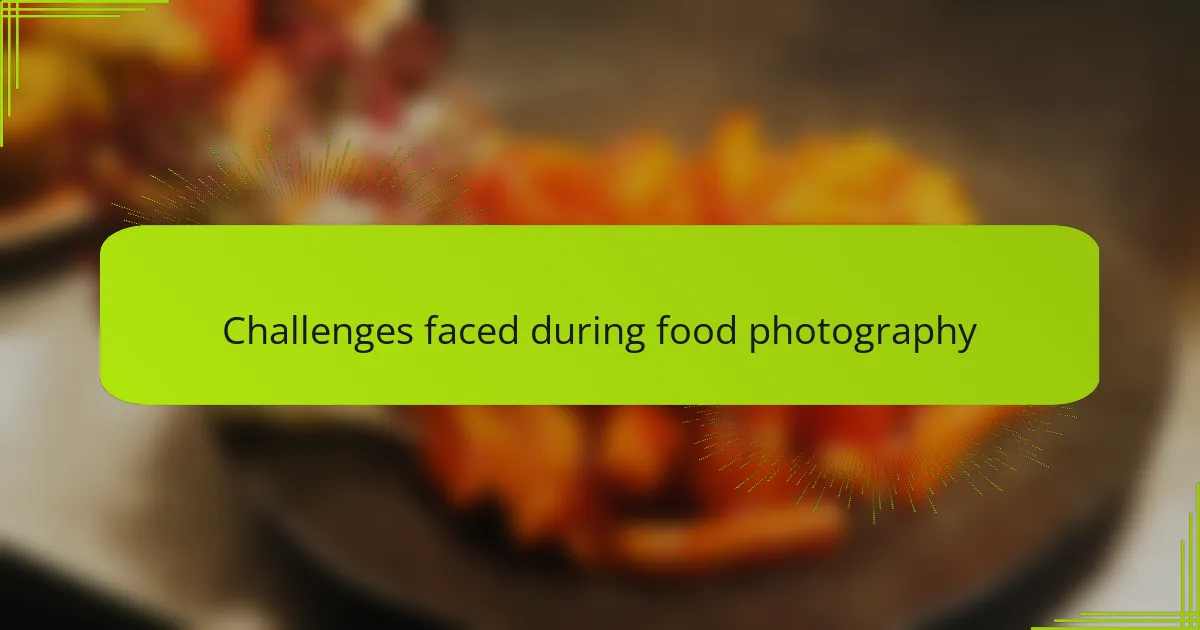
Challenges faced during food photography
One challenge I faced early on was battling inconsistent lighting. Sometimes, even the most carefully arranged dessert would look dull or shadowy because the light shifted unexpectedly. Have you ever spent ages perfecting a shot, only to find the natural light fading right as you clicked the shutter? It can be frustrating, but learning to work with diffusers and reflectors helped me regain control.
Another hurdle was mastering the timing. Food isn’t static—melting chocolate or whipped cream can change texture within minutes. I remember rushing through shots, trying to capture the perfect moment before a glossy glaze lost its shine. It taught me how critical it is to plan every detail beforehand and work efficiently under pressure.
Styling also brought its own set of challenges. Finding the right props without cluttering the frame felt overwhelming at first. I used to pile on too many items, thinking more meant better storytelling, but it only distracted from the dessert’s beauty. Have you ever felt lost trying to balance minimalism and detail? Over time, I realized that simplicity often makes the dessert shine brightest.
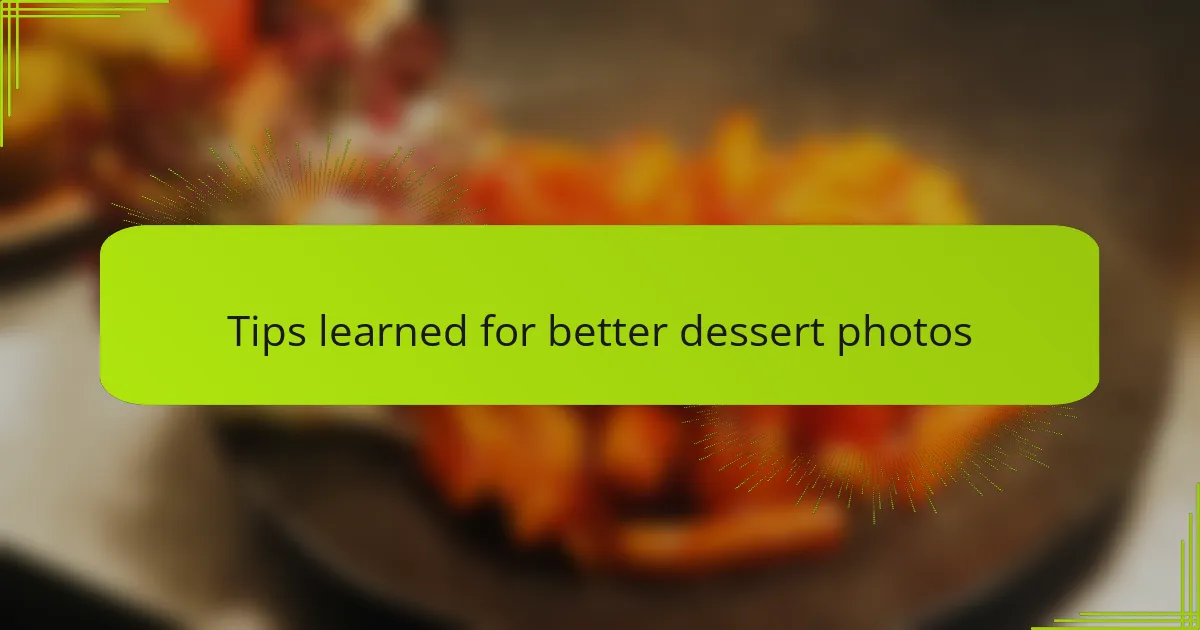
Tips learned for better dessert photos
One tip that really stuck with me was to always be mindful of the background. Early on, I didn’t pay much attention to what was behind my desserts, only to realize later that a cluttered or overly bright backdrop could steal the spotlight. Have you ever looked at a photo and felt like something just didn’t quite fit? Simplifying the scene lets the dessert truly shine, making it the undisputed star.
I also learned that patience is key when working with light. There were moments when I felt rushed, snapping pictures too quickly and missing the perfect glow. Slowing down, waiting for the softest light or adjusting my setup gently, made my images feel warmer and more inviting. Isn’t it surprising how giving yourself a little extra time can turn a good shot into a stunning one?
Another game-changing tip was to focus on details like texture and garnishes. I once added a sprinkle of crushed nuts to a slice of cake just before shooting, and that tiny tweak added so much depth to the image. Paying attention to these small elements helps the viewer almost taste the dessert through the photo. Have you ever noticed how a slight shine on chocolate or a perfect dusting of cinnamon can make all the difference? That’s where the magic happens.
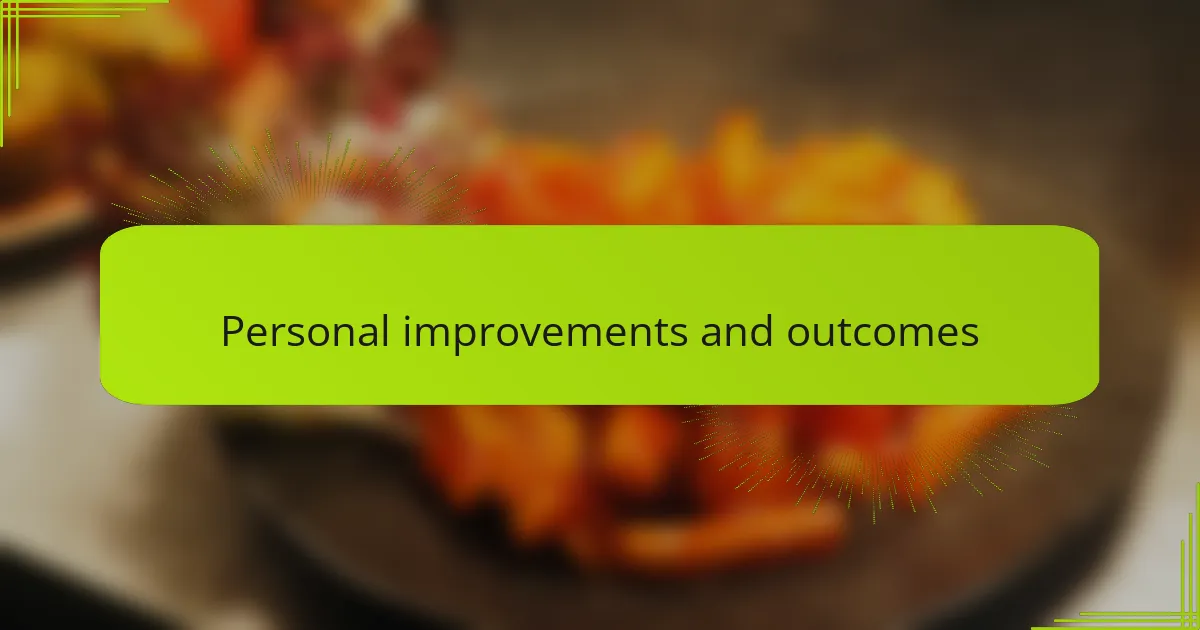
Personal improvements and outcomes
I noticed a real shift in how I approach my dessert photography after the workshops. Suddenly, I wasn’t just snapping pictures; I was crafting images that evoke a feeling or a craving. Have you ever seen a photo that makes you pause and want to try the dessert right away? That’s exactly the outcome I started achieving, and it felt incredibly rewarding.
One of the biggest personal improvements was gaining confidence. Before, I hesitated to experiment with lighting or composition, worried I’d ruin the shot. But the workshop’s hands-on practice pushed me to trust my instincts and try different angles or styles. It’s amazing how much that freedom changed the quality and authenticity of my photos.
Beyond technical skills, I also developed a more patient mindset. I learned that rushing through a shoot often meant missing the perfect moment—the softest light or the freshest texture. Have you ever captured a shot just a minute too late? I have, and now I give myself time to observe and wait, which makes all the difference in the final image.
